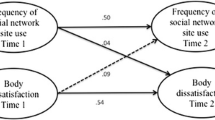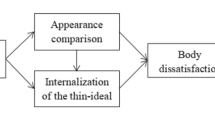Abstract
Relations among body image satisfaction and social comparisons to either same-sex peers or media models were examined in 2 studies of adolescent boys and girls. In the first study, 9th and 10th graders described their conceptions of attractiveness for same- and opposite-sex adolescents. These attractiveness attributes were then used in Study 2 in which 7th- and 10th-grade boys and girls reported on social comparisons to models/celebrities and same-sex peers. Body dissatisfaction was also assessed. The results confirmed that both same-sex peers and models/celebrities were the targets of social comparisons for physical attributes, but comparisons on personal and social attributes were more likely directed toward same-sex peers. For boys and girls, weight comparisons to both peer and model targets were primary correlates of body dissatisfaction. In addition, shape comparisons reported by the girls and facial comparisons endorsed by the boys also related to body dissatisfaction. Gender differences in social comparison indicated that girls reported more social comparisons across targets and attributes. Results are discussed in terms of the role of social comparison and peer context for body image during adolescence.
Similar content being viewed by others
REFERENCES
Abell, S.C., & Richards, M. H. (1996). The relationship between body shape satisfaction and selfesteem: An investigation of gender and class difference. Journal of Youth and Adolescence, 25, 691-703.
Attie, I., & Brooks-Gunn, J. (1989). Development of eating problems in adolescent girls: A longitudinal study. Developmental Psychology, 25, 70-79.
Botta, R. A. (1999). Television images and adolescent girls' body image disturbance. Journal of Communication, 49, 22-41.
Brooks-Gunn, J., Warren, M. P., Rosso, J., & Gargiulo, J. (1987). Validity of self-report measures of girls' pubertal status. Child Development, 58, 829-841.
Brown, B. B., Mory, M. S., & Kinney, D. (1994). Casting adolescent crowds in a relational perspective: Caricature, channel, and context. In R. Montemayor, G. R. Adams, & T. P. Gullotta (Eds.), Personal relationships during adolescence (pp. 123-167). Thousand Oaks, CA: Sage.
Bukowski, W. M., Hoza, B., & Boivin, M. (1993). Popularity, friendship, and emotional adjustment during early adolescence. New Directions for Child Development, 60, 23-37.
Cash, T. F., & Deagle, E. A. (1997). The nature and extent of body-image disturbances in anorexia nervosa and bulimia nervosa: A meta-analysis. International Journal of Eating Disorders, 22, 107-125.
Cohane, G. H., & Pope, H. G. (2001). Body image in boys: A review of the literature. International Journal of Eating Disorders, 29, 373-379.
Cohn, L. D., Adler, N. E., Irwin, C. E., Jr., Millstein, S. G., Kegeles, S. M., & Stone. G. (1987). Body-figure preferences in male and female adolescents. Journal of Abonormal Psychology, 96, 276-279.
Cusumano, D. L., & Thompson, J. K. (1997). Body image and body shape ideals in magazines: Exposures, awareness, and internalization. Sex Roles, 37, 701-721.
Erkut, S., Szalacha, L. A., Garcia Coll, C., & Alarcon, O. (2000). Puerto Rican early adolescents' self-esteem patterns. Journal of Research on Adolescence, 10, 339-364.
Faith, M. S., Leon, M. A., & Allison, D. B. (1997). The effects of self-generated comparison targets, BMI, and social comparison tendencies on body image appraisal. Eating Disorders, 5, 128-140.
Fallon, A. E., & Rozin, P. (1985). Sex differences in perceptions of desirable body shape. Journal of Abnormal Psychology, 94, 102-105.
Feingold, A. (1990). Gender differences in effects of physical attractiveness on romantic attraction: A comparison across five research paradigms. Journal of Personality and Social Psychology, 59, 981-993.
Franzoi, S. L., & Herzog, M. E. (1987). Judging physical attractiveness: What body aspects do we use? Personality and Social Psychology Bulletin, 13, 19-33.
Franzoi, S. L., & Shields, S. S. (1984). The body esteem scale: Multidimensional structure and sex differences in a college population. Journal of Personality Assessment, 48, 173-178.
Garner, D. M., Olmstead, M. P., & Polivy, J. (1983). Development and validation of a multidimensional eating disorder inventory for anorexia nervosa and bulimia. International Journal of Eating Disorders, 2, 15-34.
Graybill, F. A., & Iyer, H. K. (1994). Regression analysis: Concepts and applications. Belmont, CA: Duxbury Press.
Graziano, W.G., Brothen, T., & Berscheid, E. (1978). Height and attraction:Do men and women see eye to eye? Journal of Personality, 46, 128-145.
Graziano, W. G., Jensen-Campbell, L. A., Shebilske, L. J., & Lundgren, S. R. (1993). Social influence, sex differences, and judgments of beauty: Putting the interpersonal back in interpersonal attraction. Journal of Personality and Social Psychology, 65, 522-531.
Harter, S. (1998). The development of self-representations. In W. Damon (Series Ed.) & N. Eisenberg (Vol. Ed.), Handbook of child psychology: Vol. 3. Social, emotional, and personality development (5th ed., pp. 553-617). New York: Wiley.
Heinberg, L. J., & Thompson, J. K. (1992a). The effects of figure size feedback (positive vs. negative) and target comparison group (particularistic vs. universalistic) on body image disturbance. International Journal of Eating Disorders, 12, 441-448.
Heinberg, L. J., & Thompson, J. K. (1992b). Social comparison: Gender, target importance ratings, and relation to body image disturbance. Journal of Social Behavior and Personality, 7, 335-344.
Jensen-Campbell, L. A., Graziano, W. G., & West, S. G. (1995). Dominance, prosocial orientation, and female preferences: Do nice guys really finish last? Journal of Personality and Social Psychology, 68, 427-440.
Jones, D. C., Vigfusdottir, T., & Lee, Y. (2002). Body image, internalization, and the appearance culture among adolescent girls and boys: Conversations, criticism, and appearance magazines. Manuscript submitted for publication.
Leon, G. R., Fulkerson, J. A., Perry, C. L., & Cudeck, R. (1993). Personality and behavioral vulnerabilities associated with risk status for eating disorders in adolescent girls. Journal of Abnormal Psychology, 102, 438-444.
Lerner, R. M., Lerner, J. V., Hess, L. E., Schwab, J., Jovanovic, J., Talwar, R., et al. (1991). Physical attractiveness and psychosocial functioning among early adolescents. Journal of Early Adolescence, 11, 300-320.
McCreary, D. R., & Sasse, D.K. (2000). Anexploration of the drive for muscularity in adolescent boys and girls. Journal of American College Health, 48, 297-304.
Merten, D. E. (1996). Burnout as cheerleader: The cultural basis for prestige and privilege in junior high school. Anthropology and Education Quarterly, 27, 51-70.
Milkie, M. A. (1999). Social comparisons, reflected appraisals, and mass media: The impact of pervasive beauty images on black and white girls' self-concepts. Social Psychology Quarterly, 62, 190-210.
Miller, D. T., Turnbull, W., & McFarland, C. (1988). Particularistic and universalistic evaluation in the social comparison process. Journal of Personality and Social Psychology, 55, 908-917.
Oliver, K. K., & Thelen, M. H. (1996). Children's perceptions of peer influence on eating concerns. Behavior Therapy, 27, 25-39.
Parker, S., Nichter, M., Nichter, M., Vuckovic, N., Sims, C., & Ritenbaugh, C. (1995). Body image and weight concerns among African American and white adolescent females: Differences that make a difference. Human Organization, 54, 103-114.
Paxton, S. J., Schutz, H. K., Wertheim, E. H., & Muir, S. L. (1999). Friendship cliques and peer influences in body image concerns, dietary restraint, extreme weight-loss behaviors, and binge eating in adolescent girls. Journal of Abnormal Psychology, 108, 255-266.
Pelham, B.W., & Wachsmuth, J.O. (1995).The waxing and waning of the social self: Assimilation and contrast in social comparison. Journal of Personality and Social Psychology, 69, 825-838.
Ricciardelli, L. A., & McCabe, M. P. (2001). Self-esteem and negative affect as moderators of sociocultural influences on body dissatisfaction, strategies to decrease weight, and strategies to increase muscles among adolescent boys and girls. Sex Roles, 44, 189-207.
Richards, M. H., Casper, R. C., & Larson, R. (1990). Weight and eating concerns among pre-and young adolescent boys and girls. Journal of Adolescent Health Care, 11, 203-209.
Rosenblum, G.D., & Lewis, M. (1999). The relations among body image, physical attractiveness, and body mass in adolescence. Child Development, 70, 50-64.
Ruble, D. N. (1983). The development of social-comparison processes and their role in achievement-related self-socialization. In E. T. Higgins, D. N. Ruble, & W. W. Hartup (Eds.), Social cognition and social development: A sociocultural perspective (pp. 134-157). London: Cambridge University Press.
Spitzer, B. L., Henderson, L. A., & Zivian, M. T. (1999). Gender differences in population versus media body sizes: A comparison over four decades. Sex Roles, 40, 545-565.
Stormer, S. M., & Thompson, J. E. (1996). Explanations of body image disturbance: A test of maturational status, negative verbal commentary, social comparison, and sociocultural hypotheses. International Journal of Eating Disorders, 19, 193-202.
Taylor, C. B., Sharpe, T., Shisslak, C., Bryson, S., Estes, L. S., Gray, N., et al. (1998). Factors associated with weight concerns in adolescent girls. International Journal of Eating Disorders, 24, 31-42.
Thompson, J. E., Coovert, M. D., & Stormer, S.M. (1999). Body image, social comparison, and eating disturbance: A covariance structure modeling investigation. International Journal of Eating Disorders, 26, 43-51.
Wood, J. V. (1989). Theory and research concerning social comparisons of personal attributes. Psychological Bulletin, 106, 231-248.
Youniss, J., McLellan, J. A., & Strouse, D. (1994). “We're popular, but we're not snobs”: Adolescents describe their crowds. In R. Montemayor, G. R. Adams, & T. P. Gullotta (Eds.), Personal relationships during adolescence (pp. 101-122). Thousand Oaks, CA: Sage.
Author information
Authors and Affiliations
Rights and permissions
About this article
Cite this article
Jones, D.C. Social Comparison and Body Image: Attractiveness Comparisons to Models and Peers Among Adolescent Girls and Boys. Sex Roles 45, 645–664 (2001). https://doi.org/10.1023/A:1014815725852
Issue Date:
DOI: https://doi.org/10.1023/A:1014815725852




